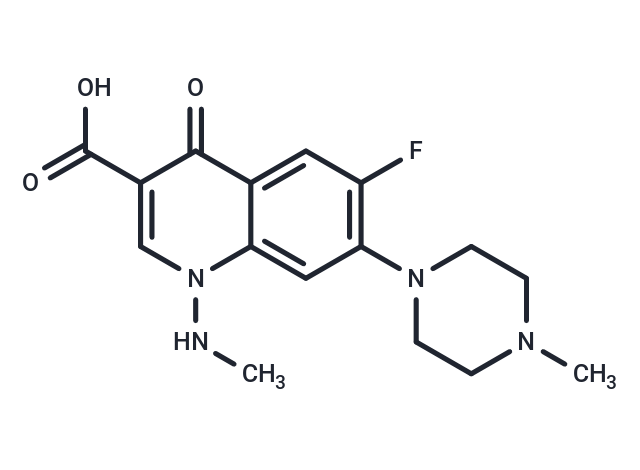Shopping Cart
- Remove All
 Your shopping cart is currently empty
Your shopping cart is currently empty

Amifloxacin (Win49375) is a synthetic antibacterial compound demonstrating moderate activity against Staphylococcus aureus, with MICs ≤ 2 micrograms/ml.

| Pack Size | Price | Availability | Quantity |
|---|---|---|---|
| 1 mg | $123 | In Stock | |
| 5 mg | $297 | In Stock | |
| 10 mg | $496 | In Stock | |
| 25 mg | $793 | In Stock | |
| 50 mg | $1,070 | In Stock | |
| 1 mL x 10 mM (in DMSO) | $697 | In Stock |
| Description | Amifloxacin (Win49375) is a synthetic antibacterial compound demonstrating moderate activity against Staphylococcus aureus, with MICs ≤ 2 micrograms/ml. |
| Targets&IC50 | S. aureus:less than or equal to 2 μg/mL (MICs) |
| In vitro | The activity of Amifloxacin in vitro was comparable to those of norfloxacin and pefloxacin against Enterobacteriaceae and generally greater than those of tobramycin and cefotaxime. Amifloxacin was more active in vitro than carbenicillin and mezlocillin against Pseudomonas aeruginosa isolates[1]. |
| In vivo | Against systemic, gram-negative bacterial infections in mice, Amifloxacin was generally less active than cefotaxime but more active than gentamicin. WIN 49548, the major piperazinyl-N-desmethyl metabolite of Amifloxacin, was aa effective as the parent drug against experimental infections in mice when given parenterally. When administered orally, however, this metabolite was less potent than Amifloxacin. Amifloxacin was highly active by the oral route, with 50% effective doses within two- to threefold of those obtained with parenteral medication[1]. |
| Alias | Win49375 |
| Molecular Weight | 334.35 |
| Formula | C16H19FN4O3 |
| Cas No. | 86393-37-5 |
| Smiles | CNn1cc(C(O)=O)c(=O)c2cc(F)c(cc12)N1CCN(C)CC1 |
| Relative Density. | 1.44 g/cm3 (Predicted) |
| Storage | Powder: -20°C for 3 years | In solvent: -80°C for 1 year | Shipping with blue ice. | ||||||||||||||||||||
| Solubility Information | DMSO: 4 mg/mL (11.96 mM), Sonication is recommended. | ||||||||||||||||||||
Solution Preparation Table | |||||||||||||||||||||
DMSO
| |||||||||||||||||||||

Copyright © 2015-2025 TargetMol Chemicals Inc. All Rights Reserved.